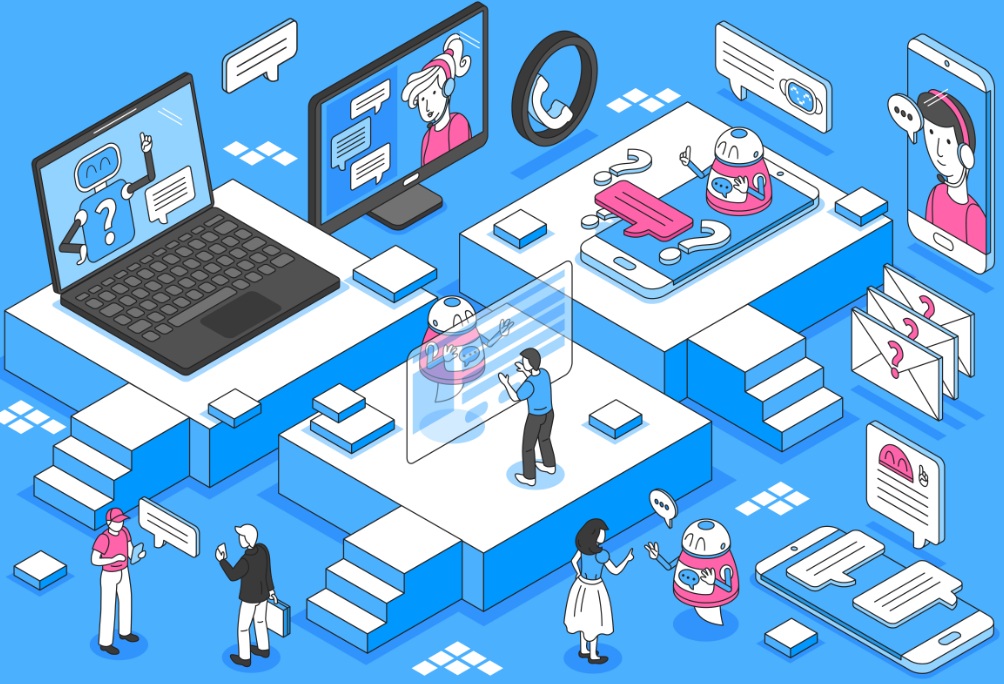Nowadays, we no longer have to spend hours on hold to get a hold of someone from the help desk or wait until the next business day to hear back from a company about an issue we have raised. Customer service has become fast-paced, thanks to innovations in technology. As a result, customer behavior and expectations have also evolved tremendously.
We have reached the age of sophisticated smart devices, tools, and systems. Take the case of “bots”— a collective term for various modern machines, software, or computer programs that replicate human dialogue by using voice commands, text chats, or both to simulate human conversations that personalize customer service.
Although it’s only in the last few years that chatbots have taken off with users and business owners, they’ve been around for quite a while. This shift in perception of chatbots and conversational interfaces was largely influenced by advancements in machine learning and artificial intelligence, as well as the thriving use of messaging apps and social media marketing.
A Brief History of Chatbots
In the 1960s, MIT professor Joseph Weizenbaum introduced ELIZA, the very first chatbot in the history of computer science. Through substitution methodology and pattern matching that simulate conversation, ELIZA functioned by identifying keywords or phrases in the input and then generating replies using those keywords from pre-programmed responses.
Kenneth Colby, an American psychiatrist, created PARRY in 1972. Modeled after a schizophrenic patient, PARRY is a natural language program that mimics schizophrenia by simulation of human s. It operates by adjusting the weights allocated to verbal inputs, triggering an intricate system of assumptions, attributions, and emotional responses.
Then in 1995, Richard Wallace invented ALICE (Artificial Linguistic Internet Computer Entity). Unlike ELIZA, the ALICE chatbot could handle more complex conversations using natural language processing. It is a universal language processing bot that conducts chats through heuristic pattern matching.
More than a decade later, a Chinese company called WeChat developed a more powerful chatbot in 2009. WeChat earned the respect of users who have been invested since the inception of this popular social media platform. It has evolved into one of the most efficient methods for marketers and corporations to lessen the labor they perform while interacting with clients online.
Cortana then debuted at Microsoft's Build 2014 developer conference. Incorporated successfully into both Windows 10 PCs and Windows phone devices, this program receives and responds to voice commands using voice recognition and appropriate algorithms.
Meanwhile, Amazon also launched Alexa in 2014, embedding the program into devices such as the Amazon Echo, Echo Dot, Echo Show, and others.
Top 5 Reasons to Invest in Chatbots
1. Offer immediate customer support 24/7
Today, almost all businesses are expected to provide online information and prompt assistance about their products and services. Being able to address inquiries round the clock increases customer satisfaction and loyalty. With efficient chatbots that can access extensive resources, you can deliver timely solutions.
2. Yield simple scalability
The most crucial thing every customer-centric company can prioritize is the ability to scale support. By incorporating cutting-edge chatbots into your customer service, you save yourself from the inconvenience of hiring more support experts and training them. As a bonus, you can gather real-time feedback since chatbots can be configured to capture data from customer interactions.
3. Elicit quicker purchases
Many people want their purchases done faster and easier due to their hectic schedules and fast-paced lifestyles. Customers that seek quick services while shopping can rely on chatbots, as they can keep up with transactional conversations quite well. These advantages of artificial intelligence for customer service allow for a significantly faster shopping experience and, ultimately, serve a larger consumer base.
4. Enhance lead and revenue generation
Improved lead creation, selection, and nurturing are all possible with chatbots. They’re capable of customizing messages based on information provided by consumers or social media platforms. This enables chatbots to ask appropriate questions, supply necessary information, and assist in converting leads to customers.
5. Cut costs on customer service operations
Statistics show that chatbots can help organizations benefit from reduced customer service costs by accelerating response times and attending up to 80% of typical inquiries. That results in saving up to 30% in customer support expenditures. Furthermore, 40% of customers don't mind at all if a chatbot or a real person assists them so long as the services they receive match their requirements.
Best Practices in Using Chatbots to Strengthen Social Media Strategy
1. Create customized experiences
A chatbot's algorithm keeps track of what users write and post on social media and then customizes the consumer experience. Chatbots can craft tailored content and personalized messaging by pulling up collected data from previous preferences and purchases.
Whether it’s on your website, Facebook messenger, or Twitter Direct Message, you can leverage your chatbot’s features to promote customer engagement and satisfaction.
2. Design a content structure
Identify the kind of content that best suits your customers as they engage in chatbot conversations. Here, you could work on the most frequently asked questions first.
Consider the type of inquiries your customers are likely to ask your chatbot so you can build the necessary processes to deliver them the most appropriate and helpful response. Then check with your staff to gain more perspective of your customers’ common concerns.
3. Develop a distinctive voice for your bot
Working on a unique personality for your chatbot makes for a human experience that represents your brand’s style and values. Brainstorm with your creative team to set an ideal and consistent voice for your chatbot.
You could even assign it a name like other companies do to remain transparent with clients and keep them informed that their queries are being handled by a bot.
Get Started with Social Media Chatbots
When traditional marketing efforts fail, consider making use of AI-powered chatbots to facilitate your social media management. Regardless of your preferred branding strategy, turning on the chatbot technology pays dividends by delivering better results.
Industry-leading companies are well underway in integrating state-of-the-art chatbots into their social media platforms—and it’s high time for you to re-evaluate your customer service approach, as well.


 Table of Content
Table of Content










